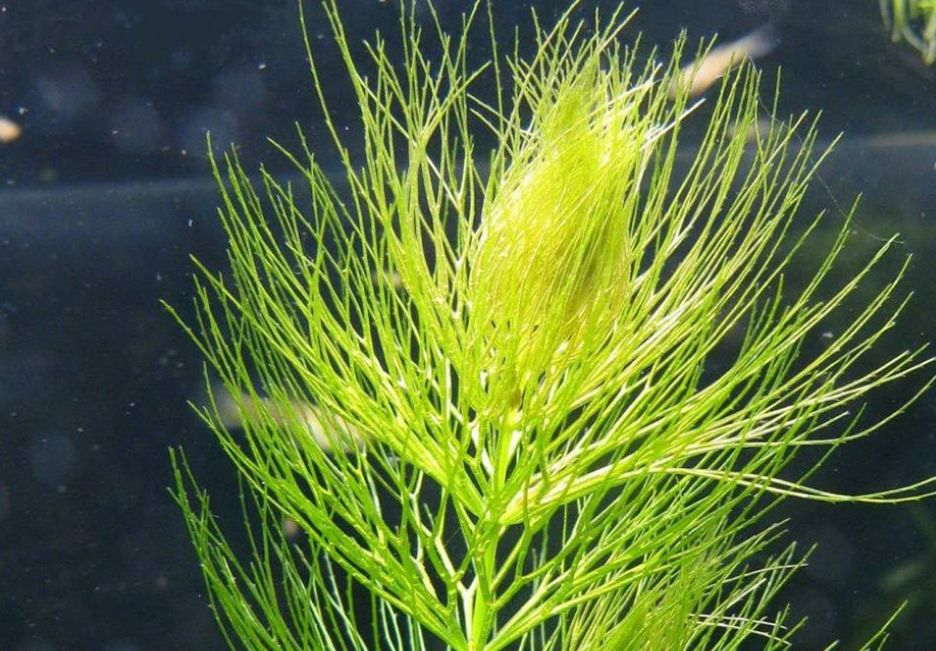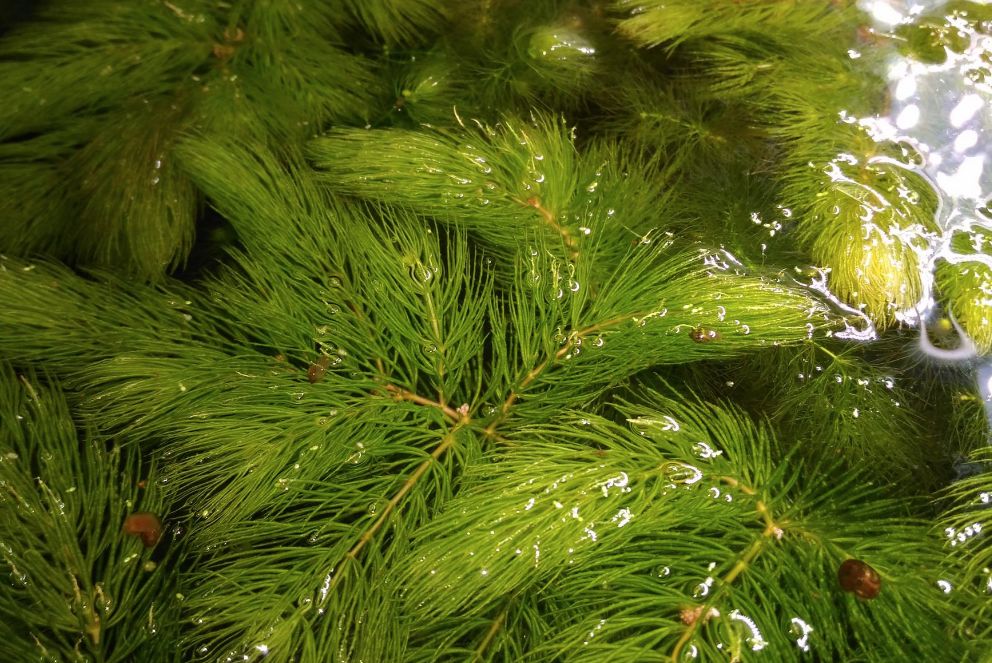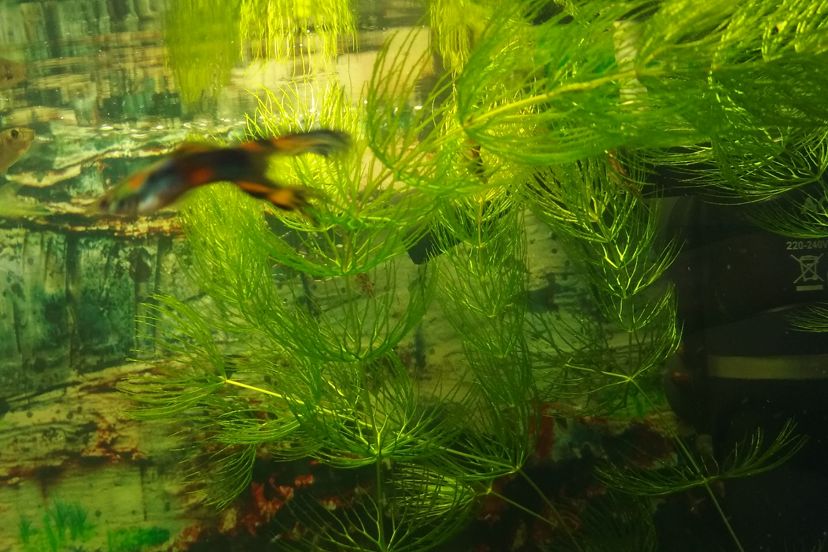Ceratophyllum demersum, commonly known as Hornwort, is a submerged aquatic plant that belongs to the family Ceratophyllaceae. It is widely distributed across the globe, found in both freshwater and brackish water environments. Hornwort is the most popular tank plant for beginners! Why? Well, simply because it is not demanding and it can grow at low illumination level, in cold water, easily reproduces and it doesn’t cost a fortune. Moreover, this plant is a good biological filter. Firstly, because it collects all ‘rubbish’ on itself including fish waste products and rot off organic matter. Secondly, because this plant effectively ‘pulls out’ nitrates (nitrogen cycle end product) from the water.

Contents
Plant Habitat in the wild
Hornwort is a plant from Ceratophyllaceae family. Several kinds of the plant are known for now. They grow in slowly flowing rivers, lakes and ponds, but they differ in their appearance. For example, in African lakes there are small sized forms of the plant with coarse leaves.
Coontail natural habitat is rather wide; this plant dwells in all regions of moderate climatic zone, it is encountered in waters from polar circle to tropical ones. The plant grows in many lentic habitats or in slow flow areas of rivers, where is it completely submerged or it fixates itself to a river bottom.
Ceratophyllum demersum is a free-floating, rootless plant with slender, branching stems that can reach lengths of up to 2 meters. The stems are densely covered with finely dissected, needle-like leaves arranged in whorls of 6-12. Hornwort exhibits several adaptations that allow it to thrive in aquatic habitats. Its flexible stems and feathery leaves reduce water resistance, enabling it to move with water currents. It also has a high surface-to-volume ratio, facilitating efficient nutrient absorption.
In the wild hornwort is food for herbivorous fishes and birds. It is also used as food for domestic swimming birds. Ceratophyllum demersum plays a significant role in aquatic ecosystems. It provides habitat and shelter for various aquatic organisms, including small invertebrates and fish fry. The dense vegetation helps in improving water quality by absorbing excess nutrients and reducing algal blooms.
While coontail has many positive attributes, it can become invasive in certain regions. In some areas, it can outcompete native aquatic vegetation and disrupt the balance of ecosystems. Therefore, it is crucial to monitor its growth and prevent its spread in sensitive habitats.

Description
We should mention that, in fact, there are several closely related species under this name and you can see between them only by studying their inflorescence. As for the other characteristics these plants are identical.
Coontail has long tough stems, its root system isn’t a developed one. That’s why the plant freely floats in medium and upper water layers. Hornwort absorbs nutrients directly from water; conducting elements of the stem are poorly developed and they contain storage matter – starch.
The plant stem can be up to 2 m long; it is branchy and it easily breaks. Its leaves are acerose and serrated on top; they are gathered in verticils (6-12 leaves in each). The leaves coloring varies from light to dark green or reddish; they are easily torn off due to lime retention.
The hornwort may fixate to the bottom substrate by means of its thin filamentary formations called rhizoids. Except holding the plant in the substrate, rhizoids also perform absorption function. The hornwort blooms with small flowers, some species have flowers gathered in little blossom cluster. This is a monoecious plant.
One of interesting features of the hornwort is that its pollination happens under water as well, which is a very rare thing even among aquatic plants.
| Feature | Description |
|---|---|
| Common Name | Hornwort, coontail |
| Scientific Name | Ceratophyllum demersum |
| Habitat | Found in freshwater and brackish water environments |
| Morphology | Slender, branching stems with whorls of 6-12 finely dissected, needle-like leaves |
| Root System | Rootless and free-floating plant |
| Size | Can reach lengths of up to 2 meters |
| Water Parameters | Prefers neutral to slightly alkaline water (pH: 6.0-7.5) |
| Temperature Range | Thrives in a wide temperature range: 10°C to 28°C (50°F to 82°F) |
| Lighting Requirements | Tolerant of various lighting conditions, but moderate to high light is ideal |
| CO2 Requirements | Can grow well without supplemental CO2, but benefits from CO2 injection in high-tech setups |
| Nutrient Demands | Relatively undemanding, but benefits from a nutrient-rich environment |
| Growth Rate | Rapid growth rate, can become invasive if not pruned regularly |
| Compatibility | Compatible with most fish and invertebrates, but may be nibbled by some herbivorous species |
| Propagation | Propagates easily through fragmentation |
| Uses | Popular in aquariums and aquatic gardening, adds natural and vibrant look to aquatic settings |
| Invasive Potential | Can become invasive in certain regions, outcompeting native vegetation in some cases |

Difficulties in keeping
This coontail has been known in aquarium husbandry since the day the latter appeared. Besides, this is one of the most renowned tank plants among beginners.
The reason of this long-lasting popularity is that hornwort is undemanding and perfectly adapts to a vast variety of environmental conditions. The plant is also known for its ability to quickly absorb nutrients dissolved in water and this way suppressing algae growth in a tank.
By getting a hornwort a beginner aquarist can sufficiently improve parameters of his new tank, since it is beneficial to settling of biological balance. As well as its owner gets the experience of how to grow and take care about tank plants without being afraid that the plant will wilt.
We should make a small comment for beginner aquarists – despite the plant unpretentiousness, yet you have to understand, that you shouldn’t expect it to survive at ‘spartan amenities’. The plant won’t grow without illumination, in really dirty tank with cold water and high concentration of toxic substances etc.
As for using hornwort as a tank plant, there are both those who support this idea and those, who don’t. In this case, you should take into account general idea of the tank decoration and your own suggestions in this respect.
Many aquarists say that this plant is a must when you first start the tank; there hornwort ensures settling of biological balance by absorbing waste products of tank dwellers. Besides, the plant produces oxygen and as a result organics accumulated in the tank quickly decomposes.
Coontail is suitable both for tanks with cold water and for tropical ones. Hornwort isn’t demanding, it grows extremely fast (in a month a plant up to 1 m long can form from one shoot). The hornwort easily recovers even from a small branch after its leaves die-off, due to which it is perfect for beginner aquarists to keep.
However, high growth rate can do a disservice when there are other plants in the tank and they can’t stand shading and lack of nutrients. Leaves and stem of the plant easily get broken and when they die-off, they become an additional source of organics in a tank.
That’s why it is necessary to maintain the tank clean and timely remove floating rot-off particles of the plant with a scoop-net and trim the shoots which are too long. These issues don’t make experienced aquarists very excited and for this reason they very seldom use in their planted tanks.
Care and keeping
Coontail is known for its rapid growth rate under favorable conditions. It is considered one of the faster-growing aquatic plants. The growth rate of Hornwort can vary based on several factors, including lighting, nutrient availability, water parameters, and overall tank conditions. You can put its bushes into the substrate or leave them floating in the water. It’s better to keep the plant in a spacious tank and regularly trim its shoots.
Water parameters
Prefers neutral to slightly alkaline water (pH: 6.0-7.5). Hornwort can thrive in a KH range of 2-20 dKH (or approximately 35-350 ppm). It is considered a moderately hardy plant and can adapt to different water conditions. Water temperature may vary within 10°C to 28°C (50°F to 82°F), however at lower temperature the growth rate of the plant slows down and its stems get down closer to the bottom.
Lighting
Hornwort can grow well in moderate to high light conditions, typically ranging from 2 to 4 watts per gallon (WPG) or approximately 0.5 to 1 watt per liter (WPL) of water. However, it can also survive in lower light intensities, around 1 WPG or lower. These plants prefer opaque light, at that daylight duration should be about 8-10 hours. Provided with intense light the plant can grow up to 3 cm long each day.
If the hornwort doesn’t get enough light, it may shed leaves and its stem edges may begin to rot. In this case it is recommended to remove rot off parts of the plant, fix the illumination issue and hornwort will quickly recover.
Substrate
Hornwort is a rootless and free-floating plant, which means it does not require a substrate in the traditional sense. It can thrive and grow without being planted in the substrate like other aquatic plants.
Nutrients
Hornwort (Ceratophyllum demersum) is considered a relatively low-maintenance aquatic plant when it comes to nutrient requirements. However, providing adequate nutrients can contribute to its growth and overall health. The hornwort absorb nutrients – phosphates, ammonia, CO2 and nitrites directly from water.
Ceratophyllum demersum is known for its ability to absorb and utilize ammonia as a nutrient source. Ammonia (NH3) is a toxic substance that can be released into the aquarium water through fish waste, decaying organic matter, or overfeeding. Hornwort, along with other fast growing aquatic plants, plays a significant role in maintaining water quality by absorbing and metabolizing ammonia.
CO2
Hornwort can grow without supplemental carbon dioxide (CO2) injection, as it can obtain carbon from carbonates and dissolved CO2 in the water. However, in high-tech setups or tanks with high light intensity, providing additional CO2 can enhance growth and prevent carbon deficiency issues. If you notice slow growth or yellowing leaves, it may indicate a carbon limitation, and CO2 supplementation can be considered.
How to plant hornwort
Hornwort (Ceratophyllum demersum) is a rootless, free-floating plant that does not require planting in the substrate like most other aquatic plants. Instead, it can be anchored or floated in the aquarium. To fixate the plant in the substrate you can press it down with stones or other decorations.
Propagation
Hornwort uses vegetative reproduction. Small pieces or sprigs of the plant easily strike roots into the substrate or grow new spurs when floating in the water.
It is recommended to put hornwort into a tank if you notice that there is a lot of algae in it. The plant competes for food with algae and it will promote fast cleaning of the tank, since this is one of the ways of biological algae control.
However, in this case you shouldn’t apply algicides, because hornwort is very sensitive to their content in the tank water, and it can lead to the plant death.
Except its ornamental features, hornwort is valuable as a biological filter. Suspended particles, food remnants and algae settle on it. If for this reason the hornwort appearance becomes less attractive, it is enough just to wash it under running cold water and remove the parts which became very dirty.
Application in aquascaping
In planted tanks coontail is largely used to decorate side and back walls of the tank and to hide the equipment. Thickly planted hornwort looks good in the background together with other long-stalked tank plants. But more often it just floats in medium tank water layer.

Tank mates
This beautiful plant can be a food for phytovorous species such as goldfish. Thin leaves of the plant are a good shelter for small sized tank fishes and their juveniles, some fishes may lay eggs among the leaves.
For this reason, hornwort is often put into spawning tanks, where its serves as an additional source of oxygen and a shelter as well. Juveniles of the following live-bearing fish: guppies, swordtail, platy, molly find their shelter in leaves.
Summary
Hornwort is a perfect plant for those who are taking their first steps in aquarium husbandry. The plant is undemanding, it cleans water from the food remnants and toxic substances, grows fast and serves as a shelter for fish juveniles. For the same reasons this plant is of no interest for experienced aquarists. The plant is a rival for more demanding plants in a tank and it grows very quickly.
Sources:
- https://en.wikipedia.org/wiki/Ceratophyllum_demersum
- https://mdc.mo.gov/discover-nature/field-guide/coontail-hornwort
- https://bryology.uconn.edu/wp-content/uploads/sites/107/2020/09/2HornwortsSM.pdf
- https://www.life.illinois.edu/moss-guide/Liverworts/Overview-Liverworts+.pdf
- https://www.semanticscholar.org/paper/The-Hornworts%3A-Morphology%2C-evolution-and-Frangedakis-Shimamura/0574bb225f64d237f68c7498b34a0db7e9bf3d40